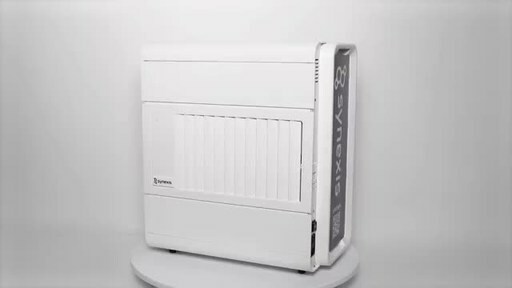LENEXA, Kan., June 15, 2021 /PRNewswire/ -- Synexis® LLC, the sole developer of patented dry hydrogen peroxide (DHP™) technology, announced a new study publication evaluating the use of DHP technology in a tertiary care hospital setting. The study, published online in the American Journal of Infection Control, assessed the efficacy of continuously operating DHP™ technology for reducing microbial contamination on privacy curtains while in use and between changings in five different units1 within the hospital. Results showed significant reductions in microbial contaminants after the first day with reductions persisting for 28 days.
"Privacy curtains, which often are not changed after each patient discharge, can become contaminated and harbor pathogens that include multidrug-resistant bacteria," said Jennifer Sanguinet, DrPh, FAPIC, CIC, MBA-HCM, BSIS, principal study investigator. "These results show that continuous use of DHP™ technology can provide an effective and automated approach for reducing potential infection risk from contamination between curtain changes."
In this study, baseline surface microbial levels were sampled from 45 privacy curtains for three consecutive days prior to installation of Synexis DHP™ units. The microbial counts from the 45 curtain samples were averaged and represented baseline counts against which the post-DHPTM implementation sampling results were compared. Results demonstrated rapid and sustained reductions in microbial counts of 99.47%, 98.55%, and 96.59% at study days 1, 7, and 28, respectively (P< 0.001 for all results compared to baseline counts).2
"Without disrupting clinical care activity or needing to remove patients from their rooms, this study shows that DHP™ technology is particularly effective at reducing contamination of privacy curtains, which are often not changed between patients," said Eric Schlote, CEO of Synexis. "This paper is the fifth peer-reviewed study published on Synexis DHP™. These results add to the growing body of peer-reviewed evidence demonstrating the effectiveness of DHP™ to reduce microbial load in multiple settings."
About Synexis
Founded in 2008, Synexis® LLC is a leader in microbial reduction and the sole developer of patented technology that creates and continuously disperses DHP™ (Dry Hydrogen Peroxide) to help reduce the presence of microbes in occupied spaces around the clock, without the need for occupants to leave the space.3,4
Synexis develops cutting-edge biodefense systems designed to make the air and surfaces cleaner. Synexis BioDefense systems are regulated by the U.S. Environmental Protection Agency (EPA) and state governments as antimicrobial devices. Accordingly, Synexis Systems are produced in an EPA-registered facility and packaged and labeled in accordance with EPA regulations appearing at 40 CFR 152.500. The Synexis system is Underwriter Laboratories (UL) Certified to produce no ozone and works continuously without disruptions in normal operations or workflow.5 Synexis currently holds 16 patents with 16 pending.6 In addition, Synexis DHP technology is supported by data from five peer-reviewed studies.7,8,9,10,11
For more information, visit Synexis.com.
Disclaimer: Synexis is not making any claim that the study described reflects the product's ability to prevent the spread of the SARS-CoV-2 virus. The FDA has not approved DHP™ for reducing the spread of the virus.
1 Units included the pediatric emergency department, pediatric intensive care unit, adult oncology service, adult Cardiovascular Trauma Intensive Care Services, and adult Trauma Surgical Intensive Care.
2 Sanguinet, J., & Lee, C. An effective and automated approach for reducing infection risk from contaminated privacy curtains. AJIC (2021). https://www.ajicjournal.org/article/S0196-6553(21)00402-8/fulltext.
3 Synexis https://synexis.com/patents/. Accessed April 12, 2021.
4 UL Certification numbers: Blade UL E482400, Sentry UL E495096 and Sphere UL 2998.
5 UL Certification numbers: Blade UL E482400, Sentry UL E495096 and Sphere UL 2998.
6 Synexis https://synexis.com/patents/. Accessed April 12, 2021.
7 Infection Specialists and Pharmacists Share Responsibility for Ensuring Patient Safety; Pharmacy Times. Published November 23, 2020.
8 Melgar, M., et al. Effectivness of dry hydrogen peroxide on reducing environmental microbial bioburden risk in a pediatric oncology intensive care unit. AJIC (2020). https://doi.org/10.1016/j.ajic.2020.08.026.
9 Melo, E.F. & McElreath, J.S. & Wilson, J.L. & Lara, Leonardo & Cox, N.A. & Jordan, Brian. (2020). Effects of a dry hydrogen peroxide disinfection system used in an egg cooler on hatchability and chick quality. Poultry Science. Vol. 99, Nov. 2020. https://doi.org/10.1016/j.psj.2020.05.050.
10 Sanguinet, J., & Lee, C. An effective and automated approach for reducing infection risk from contaminated privacy curtains. AJIC (2021). https://www.ajicjournal.org/article/S0196-6553(21)00402-8/fulltext.
11 Herman CK, Hess J, Cerra C. Dilute Hydrogen Peroxide Technology for Reduction of Microbial Colonization in the Hospital Setting. AJIC. 2015;43(6S):S25-S26. doi: 10.1016/j.ajic.2015.04.064.
SOURCE Synexis LLC

Related Links
WANT YOUR COMPANY'S NEWS FEATURED ON PRNEWSWIRE.COM?
Newsrooms &
Influencers
Digital Media
Outlets
Journalists
Opted In





Share this article